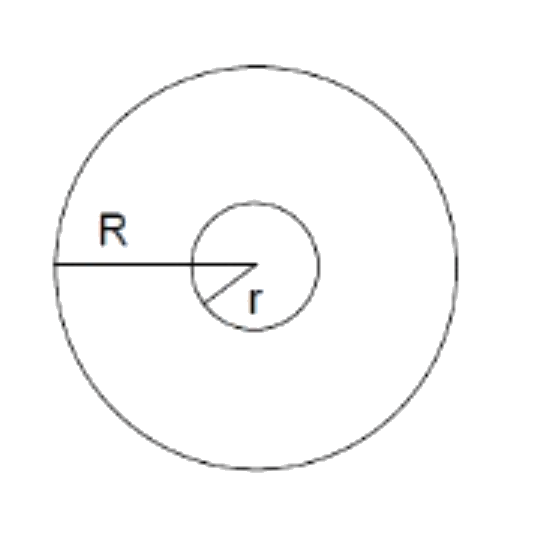The conducting circular loops of radii are placed in the same plane with their centres coinciding. If , the mutual inductance M between them will be directly proportional to
The correct Answer is:D
To solve the problem of determining the mutual inductance M between two conducting circular loops of radii R1 and R2 (where R1≫R2), we can follow these steps:
Step 1: Understanding Mutual Inductance
Mutual inductance M is defined as the ratio of the magnetic flux Φ through one coil due to the current in another coil. In this case, we will consider the larger loop (radius R1) carrying a current I1 and the smaller loop (radius R2).
Step 2: Magnetic Field at the Center of the Larger Loop
The magnetic field B at the center of a circular loop of radius R1 carrying a current I1 is given by the formula:
B=μ0I12R1
where μ0 is the permeability of free space.
Step 3: Area of the Smaller Loop
The area A2 of the smaller loop (radius R2) is:
A2=πR22
Step 4: Magnetic Flux through the Smaller Loop
The magnetic flux Φ2 through the smaller loop due to the magnetic field produced by the larger loop is given by:
Φ2=B⋅A2=(μ0I12R1)⋅(πR22)
Step 5: Expressing Mutual Inductance
The mutual inductance M can be expressed in terms of the magnetic flux and the current in the larger loop:
M=Φ2I1=(μ0I12R1)⋅(πR22)I1
This simplifies to:
M=μ0πR222R1
Step 6: Identifying the Proportionality
From the expression derived for mutual inductance M, we can see that:
M∝R22R1
Thus, the mutual inductance M is directly proportional to R22 and inversely proportional to R1.
Conclusion
The mutual inductance M between the two loops is directly proportional to R22 and inversely proportional to R1.
Mutual inductance M is defined as the ratio of the magnetic flux Φ through one coil due to the current in another coil. In this case, we will consider the larger loop (radius R1) carrying a current I1 and the smaller loop (radius R2).
The magnetic field B at the center of a circular loop of radius R1 carrying a current I1 is given by the formula:
B=μ0I12R1
where μ0 is the permeability of free space.
The area A2 of the smaller loop (radius R2) is:
A2=πR22
The magnetic flux Φ2 through the smaller loop due to the magnetic field produced by the larger loop is given by:
Φ2=B⋅A2=(μ0I12R1)⋅(πR22)
The mutual inductance M can be expressed in terms of the magnetic flux and the current in the larger loop:
M=Φ2I1=(μ0I12R1)⋅(πR22)I1
This simplifies to:
M=μ0πR222R1
From the expression derived for mutual inductance M, we can see that:
M∝R22R1
Thus, the mutual inductance M is directly proportional to R22 and inversely proportional to R1.
The mutual inductance M between the two loops is directly proportional to R22 and inversely proportional to R1.
Topper's Solved these Questions
- BOOK - DC PANDEY ENGLISHCHAPTER - ELECTROMAGNETIC INDUCTIONEXERCISE - Medical entrance special format questions17videos
ELECTROMAGNETIC INDUCTION
- BOOK - DC PANDEY ENGLISHCHAPTER - ELECTROMAGNETIC INDUCTIONEXERCISE - Match the columns5videos
ELECTROMAGNETIC INDUCTION
- BOOK - DC PANDEY ENGLISHCHAPTER - ELECTROMAGNETIC INDUCTIONEXERCISE - Check point60videos
ELECTROMAGNETIC INDUCTION
- BOOK - DC PANDEY ENGLISHCHAPTER - CURRENT ELECTRICITYEXERCISE - Medical entrances gallery97videos
CURRENT ELECTRICITY
- BOOK - DC PANDEY ENGLISHCHAPTER - ELECTROMAGNETIC WAVESEXERCISE - Sec C22videos
ELECTROMAGNETIC WAVES
Similar Questions
Two conducting circular loops of radii R1andR2 are placed in the same plane with their centres coincidingt. Find the mutual inductane between them assuming R2<<R1.
View SolutionTwo concentric circular coils of radius r and R are placed coaxially with centres coinciding If R>>r then calculate the mutual inductance the coils.
View SolutionThree plates A, B and C are placed close to each other with +Q charge given to the middle plate. The inner surfaces to A and C can be connected to earth through plate D and keys K1 and K2 . The plates D is a dielectric slab with dielectric constant K1 then the charge that will flow through plate D and keys K1 and K2 . The plate D is a dielectric slab with dielectric constant K, then the charge that will flow though plate D when K2 is closed and K2 is open is
 View Solution
View SolutionTwo circular coils, one of smaller radius r1 and the other of very large radius r2 are placed co-axially with centres coinciding. Obtain the mutual inductance of the arrangement.
View SolutionTwo thin metallic spherical shells of radii r1 and r2 (r1<r2) are placed with their centres coinciding. A material of thermal conductivity K is filled in the space between the shells. The inner shells is maintained at temperature θ1 .and the outer shell at temperature θ2 (θ1<θ2). Calculate the rate at which heat flows radially through the material.
 View Solution
View SolutionTwo thin metallic spherical shells of radii r1 and r2 (r1<r2) are placed with their centres coinciding. A material of thermal conductivity K is filled in the space between the shells. The inner shells is maintained at temperature θ1 and the outer shell at temperature θ2 (θ1<θ2). Calculate the rate at which heat flows radially through the material.
 View Solution
View SolutionSpheres of the same material and same radius r are touching each other. Show that gravitational force between them is directly proportional to r4.
View SolutionSpheres of the same material and same radius r are touching each other. Show that gravitational force between them is directly proportional to r4.
View SolutionA small coil of radius r is placed at the centre of a large coil of radius R, where R>>r. The two coils are coplanar. The mutual inductance between the coils is proportional to
View SolutionTwo concentric co - planar circular loops of radius R and r(<<R) are placed as shown in the figure. The mutual inductance of the system will be
 View Solution
View Solution

